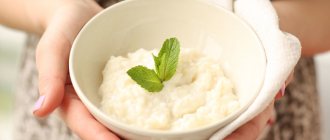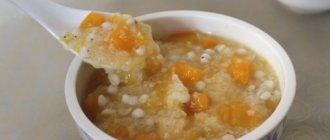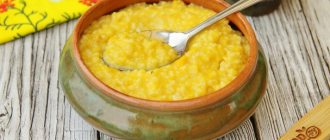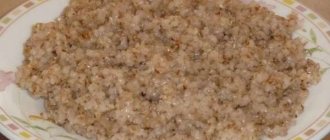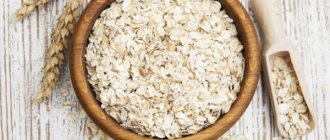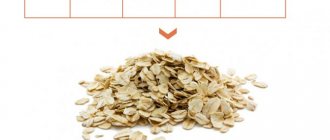Pumpkin porridge is a dish familiar to many from childhood. With milk or water, with the addition of cereals, fruits, dried fruits and nuts - there are many recipes for preparing this delicacy. The popularity of the dish is explained by the availability of the orange vegetable in our region, the ease of its cultivation, the wide variety of cooking methods and variations of ingredients. And most importantly: pumpkin porridge is extremely healthy for people of all ages.
- Calorie content
- What are the benefits of pumpkin porridge?
- Recipes Pumpkin porridge with milk
- Pumpkin porridge with rice
- Pumpkin porridge with millet cereal
Introduction to “healthy eating”
This combination of words may scare you, but there is nothing scary here. And in fact, eating healthy is even more interesting than buying ready-made semi-finished products in stores.
So, if we are talking about breakfast, then delicious rice porridge with pumpkin in a slow cooker will be a real godsend for you.
Firstly, it can be prepared in advance, for example, in the evening, and by the morning it will “open up” even more and infuse.
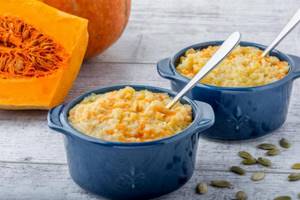
Secondly, porridge is the best idea for starting any day, especially in winter and cold, when you are too lazy to get out of bed. But the thought of a ready-made warm dish will help you cope with all the difficulties!
And finally, rice porridge with pumpkin in a saucepan, slow cooker, pot, or whatever, it’s easy to prepare anyway, and the inexpensive ingredients make this recipe even more intriguing.
Pumpkin porridge - health benefits and harms
In most cases, when choosing between pumpkin and mashed potatoes, we prefer the latter.
It is not known how this is justified, because these products are approximately in the same price category. Pumpkin is extremely easy to peel and often tastes better than potatoes.
What is the matter - social stereotypes or the harm that this vegetable can cause? Let's figure it out together.
Historical background
Pumpkin, “zucchini”, “garbuz” - all these are names for one vegetable that was extremely popular among the ancient Slavs. In ancient times, they practically did not eat potatoes as a side dish.
Instead, our ancestors cooked simple turnips or wheat, and soon pumpkin. There are a lot of theories according to which the tradition of using potatoes for food was imposed by force.
Moreover, the people believed that it weakens people and is grown to exterminate the Slavs as an ethnic community!
However, let's get back to the pumpkin. This vegetable began to be grown on the American continent by the Incas approximately three to four thousand years BC. They considered the bright orange fruits to be symbols of the sun. The Peruvian Incas prepared food from their pulp, used the seeds to treat certain ailments, and used the peel to make dishes.
A little later, the Romans and the inhabitants of the Middle Kingdom learned about the pumpkin. The latter made festive bowls from it to perform various rituals.
Among the Slavic peoples, pumpkin became widely known only about four hundred years ago. This happened thanks to Persian merchants, who often brought various “overseas” goodies.
In Europe, pumpkin became popular only in the nineteenth century.
Today, pumpkin is actively used to prepare various national dishes. Seed extracts of this fruit are often included in medications intended to normalize prostate function and reduce cholesterol levels in the body.
Benefits of pumpkin
- It retains its taste for a long period of time (up to four months).
- Due to its universal taste, it can be used both for preparing porridges and soups, and for creating pies and other baked desserts. Pumpkin is boiled, fried, stewed, baked and eaten raw.
- Excellent juice is made from its pulp, and extremely healthy oils are made from its seeds.
Pumpkin as a remedy for health
This fruit has a very low calorie content - only 37 calories per 100 grams. Moreover, it is easily digestible even by children. Pumpkin can confidently be called an ideal source of healthy vitamins and microelements, in particular protein. In addition, despite the almost complete absence of fat, it is filling, so it is difficult to overeat. This is especially important for athletes.
Pumpkin pulp contains pectins, which are water-soluble fibers. They normalize intestinal function and remove harmful substances. Among other things, pectins promote accelerated healing of skin (external) ulcers.
Useful substances in pumpkin
Pumpkin is 90% water, but contains four times more carotene than carrots. In addition, it includes fiber, vitamins B1, B2, PP, C, E, K, T (to speed up metabolism) and others.
The benefits of pumpkin porridge
Both raw and after heat treatment, pumpkin is rich in fluorine, potassium, iron, manganese, cobalt, and zinc. According to a number of scientific analyses, it significantly strengthens blood vessels, reducing the likelihood of developing heart disease. Even carriers of chronic hepatitis are recommended to eat pumpkin porridge.
It should also be noted that even for infants, many mothers give pumpkin porridge, which helps cope with constipation and improve the functioning of the baby’s gastrointestinal tract. Pediatricians recommend giving this dish to children 2 times a week.
Pumpkin porridge and weight loss
If you want to lose weight, you should definitely eat this dish, because per 100 grams of porridge there are only 23 kcal. If you have problems with the intestines or you suspect that there is slagging, eating pumpkin porridge will help you get rid of these problems, and at the same time lose extra pounds due to the normalization of the gastrointestinal tract.
Harm of pumpkin porridge
Cooked pumpkin in the form of porridge does not pose any danger, but it is better not to eat it raw in too large quantities. This is especially true for people with diabetes, gastritis and ulcers.
Source: https://zen.yandex.ru/media/id/5ad75b007ddde84cc3bc962e/tykvennaia-kasha—polza-i-vred-dlia-zdorovia-5ad75bf1c3321bb10c1cee18
Variety of cereals
Choosing rice for today's dish does not mean that it is the only one that goes well with pumpkin and other vegetables. It’s also great to add it to millet or oatmeal porridge.
And most importantly, the presence of milk does not play a big role here, which means that lean rice porridge with pumpkin will be on par with its fattier counterpart containing butter and other animal products.
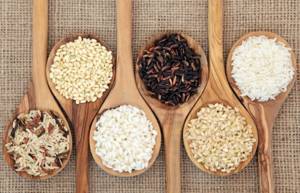
After preparing this dish, we would not advise you to concentrate on it for a long time, but on the contrary, experiment as often as possible, add and mix something new.
Thus, you will quickly identify the ingredients you like most, which means you will quickly learn how to cook correctly and tasty!
The benefits and harms of rice with milk for breakfast
The simple truth “add milk to make it tastier” also applies to rice. With it he becomes much more useful.
Milk is a source of calcium and phosphorus, which are necessary for healthy bones and teeth, so porridge cooked with it will be an excellent food for:
- children and adolescents;
- pregnant women;
- athletes;
- elderly people to prevent osteoporosis.
Substances contained in dairy products slow down the processes of digestion and absorption. Rice with milk eaten for breakfast will fill you up for a longer period than regular rice cooked in water.
Read: Benefits of squid for women
Medical studies have proven that eating this dish improves lactation in nursing women.
However, despite all the benefits of such food, there are also contraindications that you need to remember so as not to harm your health:
- Even after heat treatment, the porridge will contain lactose and casein, which, if intolerant, provoke:
- nausea;
- bloating and flatulence;
- pain and cramps in the stomach;
- diarrhea.
- Those who are watching their diet should take into account that 200 ml of milk will increase the calorie content of a serving by approximately 2 times.
- People suffering from hypercalcemia and kidney disease should pay close attention to such food - excessive indulgence in it can lead to deterioration in well-being.
Video on the topic:
Choosing the Right Pumpkin
Since this ingredient is one of the main ones in the dish, you need to choose it wisely. Of course, it is better if it is a self-grown vegetable from your garden, the quality of which you are one hundred percent sure of.
The fact is that rice porridge with pumpkin may not work out only because of the wrong type of vegetable. Choose the least watery, firm, but sweet and spicy varieties. The stronger the natural smell of pumpkin, the more aromatic the finished dish will be.

Therefore, before you buy a vegetable, it is best to ask the seller for help. You can tell him about the purpose of the pumpkin, after which it will be easier for him to find a suitable option.
Plus, if you're shopping for pumpkin when it's in season, you may even be able to find pre-cut portions.
What harm could it do?
This dish has no strict contraindications, other than individual intolerance to the vegetable.
Did you know? Of the 800 different varieties of pumpkin, only 200 can be eaten.
There are restrictions on the use of pumpkin porridge for certain painful conditions:
- diabetes;
- low stomach acidity;
- gastritis and stomach ulcers (especially during exacerbation);
- inflammatory diseases of the duodenum;
- pancreatic diseases.
Excessive consumption of the dish can be harmful for pregnant and lactating women, for people after abdominal surgery.
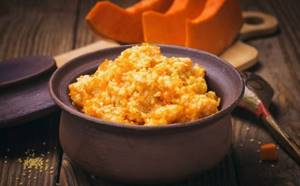
List of ingredients
In order to decide on the products, you should decide what kind of dish you want, lean or regular. When the choice is made, feel free to take the list and go to the store, although, most likely, you already have everything you need at home.
You will need the following products:
- Rice - 1 glass. In this case, you need to take the simplest option - with round rather than elongated grain. This is usually the cheapest type of rice, since it is not suitable for preparing crumbly pilaf, but only for various porridge-like dishes.
- Milk - 400 ml.
- Water - 600 ml.
- Pumpkin - 400 g.
- Sugar, salt - to taste.
- Butter - to taste.
Recipe one: rice porridge with pumpkin and milk

Now there’s just a little bit left to do, so let’s get down to the process itself, which we’ll describe point by point:
- We clean the pumpkin from the hard peel and seeds, which can then be dried in the oven and added to the finished dish. Cut it into cubes, add hot water and cook over low heat for 15-20 minutes until softened.
- Grind the boiled pumpkin to a puree (this can be done with a fork, a blender, or even leave it in its original form) and proceed to preparing rice cereal.
- We wash dry rice with water to remove excess dust and natural starch. As soon as clear water begins to flow from it, it means that you can fill it with cold water and put it on the stove.
- Cook the boiled rice for another 10-15 minutes until all the moisture disappears, then drain the cereal in a colander.
- In a separate pan, heat the milk, then add the swollen rice and cook for about 30 minutes.
- As soon as the allotted time has passed, you can safely add pumpkin, sugar and butter, mix everything thoroughly over the fire, and then, removing the pan from the stove, carefully wrap the container with the porridge with warm towels. Thus, rice porridge with pumpkin in milk will reach an ideal state while the walls of the container slowly cool, giving off their heat inside.
Calorie content
The calorie content of pumpkin porridge directly depends on the quantity and variety of ingredients added.
- on water with/without salt: 16–50 kcal (depending on the variety);
- with milk (without cereals): 85 kcal;
- with rice with milk: 91–100 kcal;
- with millet and milk: 115 kcal;
- with semolina with milk: 150 kcal.
Important! The calorie content of a dish increases significantly with the addition of cream, butter or margarine, as well as sweet fruits, dried fruits and nuts.
Minor amendments

But since rice porridge with pumpkin can also be a Lenten dish, we will offer you such an alternative. But in order for the recipe to become more original and at least slightly different from the previous one, we will add several new components:
- Pumpkin - 400 g.
- Rice (you can read about its variety in the first list) - 1 cup.
- Water - 1 l.
- Sugar, salt - to taste.
- Nuts, dried fruits - to taste. In this case, dried apricots and prunes go well with pumpkin, but if there is nothing but raisins, then they can also do a great job. Choose nuts based on your own preferences. For example, we will take walnuts, although in their place there may even be ordinary sunflower or pumpkin seeds.
